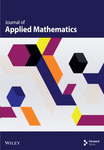Modelling Population Dynamics of Substance Abuse in the Presence of Addicted Immigrant With Real Data of Rehabilitation Cases
Abstract
Excessive intake or injection of substances, namely, medications, alcohol, and other harmful drugs, has resulted into unimaginable serious consequences, including mental health and social problems. In an attempt to understand the dynamics of substance abuse and forestall its potential spread in the population, a novel model based on nonlinear system of ordinary differential equations is formulated and analysed in this study. The model takes into account, among other important features, the influx of addicted immigrant and rehabilitation of individuals affected by substance abuse. Least squares method with minimization-constrained function is employed to fit the model with the real data of substance-induced mental cases under rehabilitation. Conditions that guarantee the existence and global asymptotic stability of steady states are established, and a key threshold quantity which measures the potential spread of substance abuse influence in a community comprising susceptible and prudent populations is determined. Sensitive parameters of the model are identified, and their effects on the dynamics of substance abuse transmission are investigated with a view to suggesting possible effective measures against the harmful spread of substance abuse in the population.
1. Introduction
Substance or drug abuse refers to misuse or excessive consumption of substance for either therapeutic or nontherapeutic effects on the mind or body of the users. Some of the psychoactive substances usually misused include but not limited to alcohol and medications such as analgesics and cough syrups, as well as some illegal narcotic drugs such as cocaine, cannabis, and heroin. Following the report by the World Health Organization (WHO) [1], at a global scale, an estimated 3.3 million deaths each year are due to harmful consumption of alcohol. In addition, between 129 and 190 million people use cannabis in the world, making it the most abused psychoactive substance. It is most frequently used in the African Region with consumption rates between 5.2% and 13.5%, especially in West and Central Africa.
In response to the difficult experiences of life, people often resort to using psychoactive substances to placate their emotions. In the process, individuals become continuously dependent on the substances, since emotional needs cannot be completely satisfied. This eventually leads to the problem of addiction and a wide range of negative consequences, including health problems, social problems, legal cases, and mental health issues. Particularly, addiction to psychoactive substances can cause damages to organs such as the lung, liver, kidney, and heart and may lead to multiorgan system failure [2, 3]. Injection of these substances through shared syringes has been reported to contribute to a high risk of contracting some deadly viruses like HIV, hepatitis B, and hepatitis C. Social problems associated with substance abuse include increased risk of motor vehicle accidents, heavy financial burden, job loss, and relationship issues. Mental disorders like depression, anxiety, psychosis, or schizophrenia are the prominent negative byproducts of substance abuse [1–3].
The need to nip the indiscriminate use of psychoactive substances in the bud is, therefore, imperative in order to avert the myriad of dangerous consequences experienced by members of the society. To do this, some attempts have been made by researchers in constructing mathematical models to analyse the dynamics of substance abuse transmission and other related studies (see, for example, [4–10]). Sharomi and Gumel [11] qualitatively studied public health’s impact of smoking dynamics by designing and analysing a compartmental model that described subpopulations of individuals based on their smoking status and incorporated mild and chain smoking populations as well as the impact of smoking-related illnesses in the community. Public-oriented intervention strategies and policies were provided for minimizing the problematics drug abuse in a population through a dynamic modelling study presented by Rossi [12]. In a bid to establish the effect of policing in the control of drug epidemic, Njagarah and Nyabadza [13] investigated how drug barons contribute to the prevalence of drug abuse circulation in the population and showed how law enforcement could be used to reduce the prevalence using mathematical modelling approach. Similarly, authors in [14] developed and analysed a drug abuse transmission model incorporating criminal law with optimal control measures. It was shown that the criminal law gives a significant decrease in the sizes of mild and heavy drug addicts in the population.
Moreover, in the study by Memarbashi and Pourhossieni [15], a model that described the spread of illicit drug in a population structured by education status of heroin users was proposed and analysed to assess the significance of educational programs on drug abuse control. Islam and Biswas [16] applied optimal control theory to study the dynamics of drug abuse and showed that educational programs and proper medical treatment as well as family-based care could be effective in reducing the negative effects of drug addiction in the shortest period of time. Akanni et al. [17] studied a model for illicit drug use in a population using dynamical system theory and suggested measures to mitigate the spread of the menace in the population. A model for the spread of drug addiction with counseling and imprisonment as preventive strategies was proposed and studied in [18]. Similarly, Abidemi [19] incorporated triple time-dependent optimal control measures, namely, treatment, corrective measure, and enlightenment campaign, into a nonlinear model of illicit drug use dynamics based on optimal control theory framework. In [20], a model on smoking dynamics was framed and incorporated the effects of media awareness with optimal control measures to achieve smoking cessation. Isa et al. [21] considered a model for drug use dynamics capturing the assumption that recovered individuals may not remain resistant to the illicit drug use. In [22], the authors framed a mathematical model to investigate the dynamics of addiction to substance abuse among women population with optimal control and showed the significance of parameters on the addict generation number. Djilali et al. [23] proposed and analysed a spatiotemporal model incorporating distributed delay to explore the consumption of heroin in a heterogeneous environment. In Zhang et al.’s [24] study, deterministic and stochastic smoking epidemic models were used to examine social interactions among different smoking levels of individuals in the population, and it was shown that proper monitoring of initial sizes of smoking population could be an effective strategy to control smoking prevalence. In an attempt to understand the influence of one of the most dangerous among drug abuse—methamphetamine (MPT) misuse—on society and restrict the surge in the population of MPT users, Abbas et al. [25] introduced cases of four-dimensional models to describe the dynamics of MPT abuse using harmonic mean type incidence term and taking relapse and the effects of migrants into consideration. The formulated models were analysed to explore the future dynamics of MPT usage in the population.
In the present study, a new model fitted to the real data of substance-induced mental cases under rehabilitation and which incorporates the influx of immigrants addicted to substance abuse is designed. The model is qualitatively and quantitatively assessed to provide insightful findings arising from the asymptotic dynamics of the substance abuse transmission and show how some key estimated parameters affect the behaviours of psychoactive substance users in the population. Throughout this study, substance and drug will be used interchangeably. The full description of the model formulation is given in Section 2. Conditions for existence and stability of substance abuse–free and substance abuse–present steady states are established in Section 3. Model-data fitting and analysis of sensitive parameters with simulations are carried out in Section 4, while in Section 5, concluding remarks are provided.
2. Model Formulation
| Variable | Description |
|---|---|
| S | Susceptible population liable to be influenced |
| L | Light drug users |
| H | Heavy drug users |
| M | Mentally ill population due to drug abuse |
| R | Population under rehabilitation |
| P | Prudent population who abstains from drug abuse |
| Parameter | |
| Π | Recruitment rate |
| a | Fraction of recruits who are heavy users by immigration |
| b | Fraction of recruits who are prudent |
| β | Effective substance abuse influence rate |
| ρ | Modification parameter for higher level of influence |
| βr | Effective substance abuse reactivation rate |
| ω | Exit rate due to rehabilitation |
| θ | Successful fraction of exit rate due to rehabilitation |
| 1 − θ | Unsuccessful fraction of exit rate due to rehabilitation (recidivist rate) |
| α | Progression rate of light users to heavy users |
| γ, σ | Transition rates of light and heavy users to mentally ill class |
| τ, ε | Rehabilitation rates for light and heavy users, respectively |
| μ | Natural death rate |
| δ | Substance abuse–induced death rate |
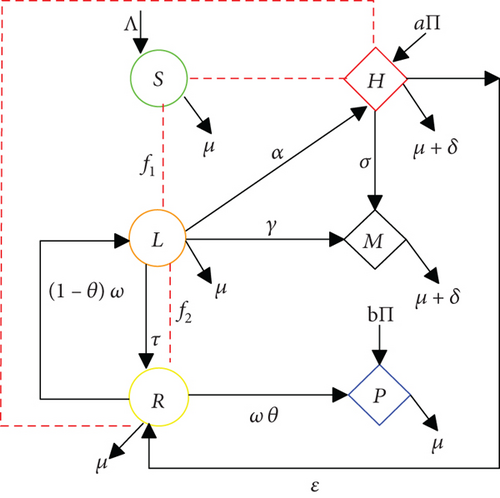
2.1. Well-Posedness of the Model
It should be mentioned that the nonnegativity of the parameters of the model (7) is valid since the model represents the dynamics of substance abuse among human population. Thus, it is necessary to verify the well-posedness of the model. To do this, the following positivity, boundedness, existence, and uniqueness results are established.
2.1.1. Nonnegativity of Solutions
Theorem 1. Given the positive initial conditions (8), the solutions S(t), L(t), H(t), M(t), R(t), and P(t) of the substance abuse model (7) are positive for all t > 0.
Proof 1. Employing the approach used in [26–28], one sees from the model (7) that
It is clear from (9) that all the rates of change on the bounding cone ℝ6 are nonnegative. As a consequence, nonnegativity of solutions of the substance abuse model (7) is established since the vector field is directed inward on all the bounding planes.
2.1.2. Invariant Region
Theorem 2. The region Δ, given by
Proof 2. Adding all the equations in the system (7) yields
It follows that
Taking the limsup as t⟶∞ gives N(t) ≤ Π/μ. Further, if N(0) ≤ Π/μ, then N(t) ≤ Π/μ. Hence, the region Δ is positively invariant.
2.1.3. Existence and Uniqueness of Solutions
Definition 1. F(w) is Lipschitz continuous in w if there exists a constant L > 0 such that
Theorem 3. There exists a unique solution w(t) of the system (10) analogous to the substance abuse model (7).
Proof 3. It suffices to show that F(w) satisfies the Lipschitz condition given in Definition 1. Considering the first equation of the model (7) and keeping in mind that N ≤ Π/μ in the positively invariant region Δ, one can show that
Similarly, considering other equations of the model (7), it can be shown that
As a consequence, F(w) satisfies the Lipschitz condition
3. Existence and Stability of Steady States
In this section, conditions for existence and stability of substance abuse–free and substance abuse–present steady states are analysed.
3.1. Substance Abuse–Free Steady State
It must be mentioned that K1K2K4 > (1 − θ)ω(αε + τK2) by algebraic simplifications and since 1 − b > 0, thereby making both numerator and denominator of in (15) positive. This ensures the positivity of the effective reproduction number of the model. Hence, the following local stability result is claimed, using Theorem 2 of [30].
3.2. Substance Abuse–Present Steady State
It is observed that the coefficient A1 of the cubic polynomial is positive since K1K2 > (τK2 + αε) by algebraic simplification. Then, invoking the spirit of Descartes’ sign rule [31], the number of positive roots of the cubic polynomial (17) depending on the threshold quantity is summarized in Table 2.
| Cases | A1 | A2 | A3 | A4 | Threshold conditions | Number of positive roots | Steady states existence |
|---|---|---|---|---|---|---|---|
| (i) | + | + | + | + | 0 | exists | |
| (ii) | + | + | + | − | 1 | exists | |
| (iii) | + | + | − | − | 1 | exists | |
| (iv) | + | + | − | + | 2 | and coexist | |
| (v) | + | − | − | + | 2 | and coexist |
As a consequence of the absence of immigrant heavy drug users fraction, it can be seen that A2 > 0 and A3 > 0 if , and by Descartes’ rule, only exists. In this case, bistability of both steady states and will no longer occur at , where may be globally asymptotically stable as would be shown in the next subsection. However, if when a = 0, only substance abuse–present steady state exists, regardless of the sign of A2.
3.3. Global Stability Analysis
In accordance with the fact that global asymptotic dynamics is an important performance metric for dynamical systems, this subsection seeks to examine how the dynamics of the substance abuse system (7) behaves around the substance abuse–free and substance abuse–present steady states.
3.3.1. Global Stability of Substance Abuse–Free Steady State
P1. For , is globally asymptotically stable
P2. , , for where is a Metzler matrix evaluated at .
Theorem 5. The substance abuse–free equilibrium of the system (7) is globally asymptotically stable provided Conditions P1 and P2 are met.
Proof 4. The functions and are obtained from (19) as follows:
Since evaluated at gives
Solving System (23) simultaneously yields
One sees that (S, R, P)⟶(S0, R0, P0) as t⟶∞, satisfying Property P1, and that is globally asymptotically stable. It remains to establish Property P2.
The M-matrix whose off-diagonal entries are nonnegative is obtained as
Then, solving for gives
It can be seen that despite 0 ≤ S ≤ S0 and 0 ≤ R ≤ R0, indicating that Property P2 is not satisfied. However, one can only achieve except that a = 0, satisfying Property P2. Therefore, it suffices to say that the equilibrium point, , of the substance abuse model is globally asymptotically stable in the absence of addicted immigrant drug users. This completes the proof.
Practically, Theorem 5 is suggesting that the eradication of substance abuse dynamics in the population cannot be possible as long as immigrant psychoactive drug users are present in the population. As a consequence, controlling substance abuse transmission in the population can only be possible if strict measures can be placed on the immigration of addicted psychoactive drugs users into the population.
3.3.2. Global Stability of Substance Abuse–Present Steady State
It has been shown that regardless of the presence or absence of the addicted immigrant drug users (i.e., whether a = 0 or a ≠ 0), the substance abuse–present steady state exists at . Hence, the investigation of the global asymptotic stability of the substance abuse model (7) around is carried out as follows.
Theorem 6. The substance abuse–present steady state, , of the system (7) is globally asymptotically stable provided the associated effective reproduction number exceeds unity, .
Proof 5. Using the following positive definite Lyapunov function of quadratic type (see [34–36]),
It is should be noted that N = S + L + H + M + R + P and N∗∗ = S∗∗ + L∗∗ + H∗∗ + M∗∗ + R∗∗ + P∗∗. Therefore, the Lyapunov function (27) becomes
Since the time derivative of (27) is given by
Recall that dN/dt = Π − μN − δ(H + M); then, (30) becomes
Consequently, implying that the time derivative of the Lyapunov function is negative semidefinite. Furthermore, provided S = S∗∗, L = L∗∗, H = H∗∗, M = M∗∗, R = R∗∗ and P = P∗∗. Then, the largest invariance set for which is the singleton In the spirit of LaSalle’s invariance principle [37], it follows that the substance abuse–present steady state is globally asymptotically stable.
4. Data Fitting and Sensitivity Analysis
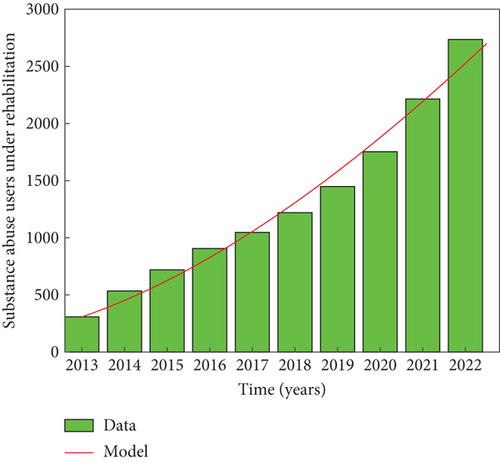
4.1. Analysis of Sensitive Parameters
Since the value of the effective reproduction number of the substance abuse model fitted to the real data is estimated to be less than one, that is, , this implies that substance abuse problem in Lagos, Nigeria, is not endemic yet, but caution should be taken to ensure that is not greater than one. Hence, it is imperative to perform the sensitivity analysis of the model in order to know how changes in the parameters of the model affect the effective reproduction number. With sensitivity analysis, the impact of some critical parameters on the dynamics of the substance abuse transmission model (23) can be determined, providing deeper insights into prevention and control efforts for mitigating the influence of substance abuse. Thus, sensitivity analysis will help guide against the outbreak of substance abuse problem in the population. To achieve this, the use is made of the forward sensitivity index defined as follows [27, 48].
Definition 2. The normalized forward sensitivity index of any variable, , depending on such parameter, p, is defined as
Consequently, the sensitivity indices of all parameters associated with the effective reproduction number, , given in (15), are shown in Table 4, using (32). The parameters with positive sensitivity index signal that any rise (fall) in their values will cause a rise (fall) in the value of . On the contrary, the parameters with negative sensitivity index signal that any increase (decrease) in their values will lead to decrease (increase) in . For example, indicates that increasing the prudent fraction of the recruitment rate by 100% will cause the effective reproduction number to decrease by 17.26%. This means that the problem of substance abuse can be abated in the community if there are more prudent individuals or stayers who abstain from the use of psychoactive substance. This result is corroborated in Figure 3, where effects of increasing other parameters are also displayed with respect to the effective reproduction number. As shown in Figure 3a, as the effective substance abuse influence rate increases through the interval 0.01 ≤ β ≤ 0.09, the reproduction number increases through . This shows that the problem of substance abuse can escalate in the population if the influences of light and heavy drug users on the susceptible population and individuals under rehabilitation are not prevented.
| Parameter | Value | Sensitivity indices |
|---|---|---|
| b | 0.1472 | −0.1726 |
| β | 0.0183 | +1.0000 |
| ρ | 1.5 | +0.0353 |
| ω | 0.0006 | +0.0328 |
| θ | 0.5606629 | −0.0001 |
| α | 0.00750351 | −0.0007 |
| σ | 0.009001 | −0.0104 |
| γ | 0.0011 | −0.0529 |
| τ | 0.0000953025 | −0.0045 |
| ε | 0.002649 | −0.0030 |
| μ | 0.01887 | −0.9285 |
| δ | 0.0002 | −0.0002 |
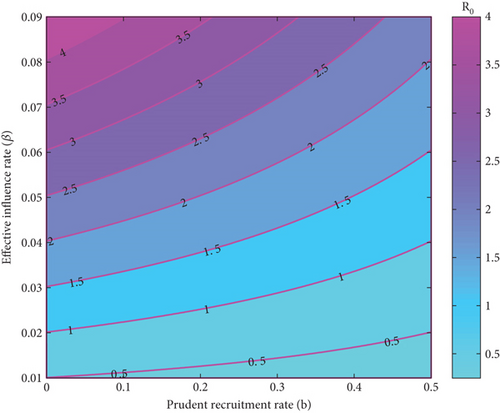
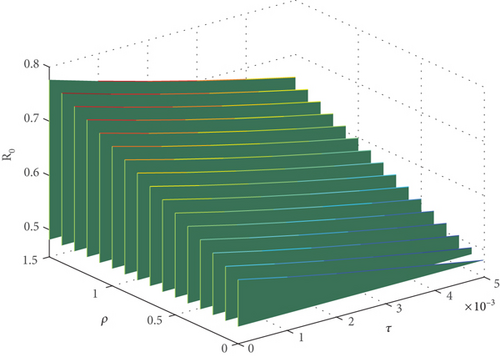
Similarly, in Figure 3b, increase in the modification parameter, ρ, for higher influence of heavy drug users will cause a rise in the value of the reproduction number , while it can also be seen that decreases with increase in the value of rehabilitation rate, τ.
4.2. Simulations and Discussion
Here, further simulations of the substance abuse model (7) are done to support the theoretical global stability results earlier obtained in Theorem 5 and Theorem 6. Using the same values of parameters as given in Table 3 in the absence of the immigrant heavy drug users (a = 0), it can be observed in Figure 4a and Figure 4b, respectively, that the trajectories of light drug users and heavy drug users converge asymptotically to the substance abuse–free equilibrium point, regardless of the initial conditions of the state variables. This establishes that the problem of substance abuse in the population can be curtailed whenever the effective reproduction number in the absence of immigrant heavy drug users, corroborating the global asymptotic stability result for the drug abuse–free equilibrium point in Theorem 5. Similarly, using the values given in Table 3, except that β = 0.05, so that , the solutions of the system converge to the substance abuse–present equilibrium point irrespective of the initial conditions of the light and heavy drug users in the population, as shown in Figure 4c and Figure 4d, respectively, corroborating the global asymptotic stability result for the drug abuse–present equilibrium point in Theorem 5.
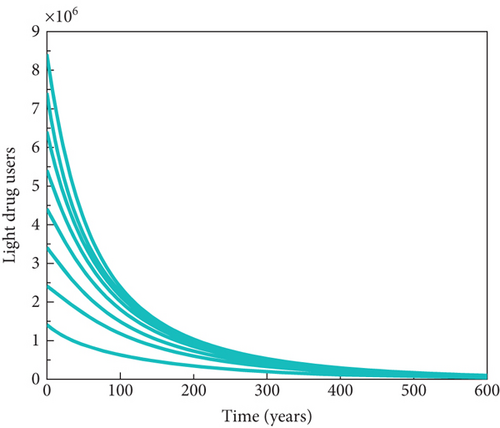

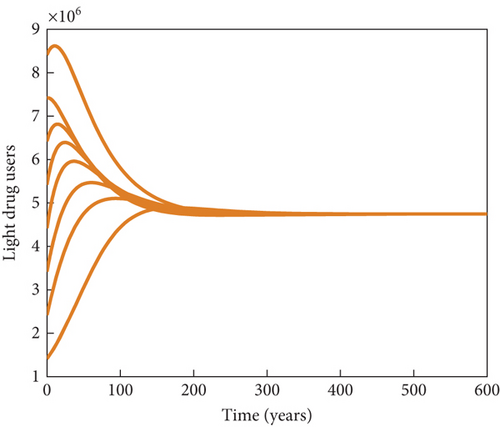
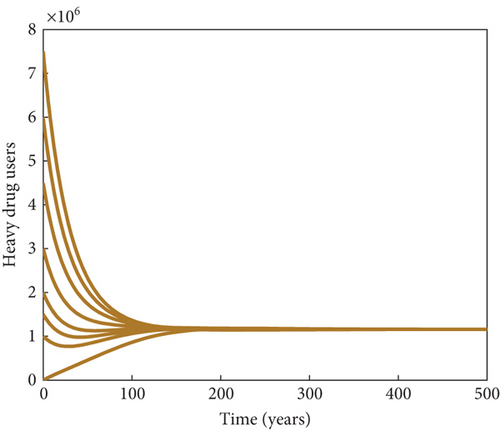
In another sense, the impact of the prudent fraction, b, of the recruitment rate is examined on the dynamics of individuals in the population, as indicated in Figure 5. It is observed that the sizes of light drug users, heavy drug users, mentally ill class, and individuals under rehabilitation reduce with time as the prudent fraction increases from 1% to 50%. This result stresses the need for increased presence of prudent individuals in the community in order to minimize the menace of substance abuse and ultimately bringing the population into a substance abuse–free state. Figure 6 shows how the system behaves in the presence of immigrant drug users. It is shown that the sizes of susceptible individuals reduces with time in the population, as the fraction for immigrant drug users rises from 1% to 50%. This increase in the value of immigrant drug users results into the increase in the numbers of heavy drug users, mentally ill class, and individuals under rehabilitation in the population. This result suggests that thorough scrutiny of immigrants could be necessary in order to stem down the spread of drug abuse in the population.
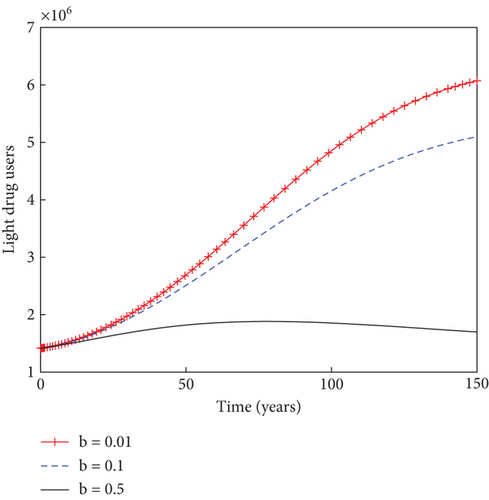
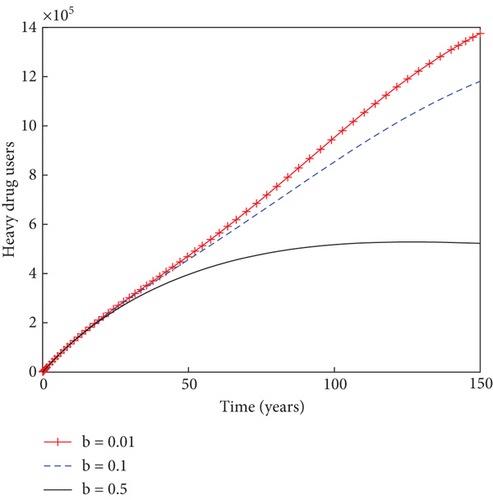
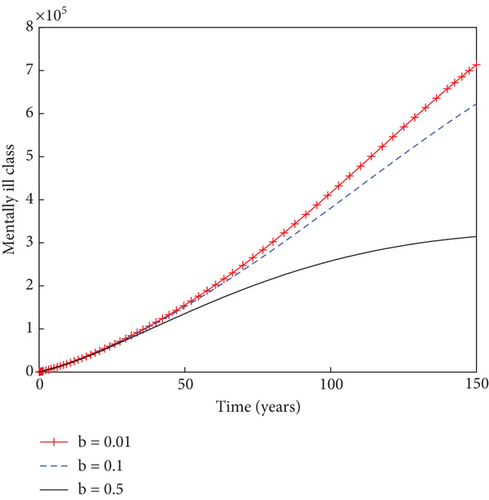
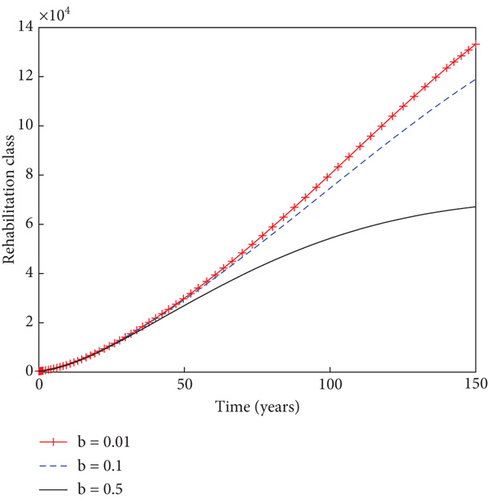
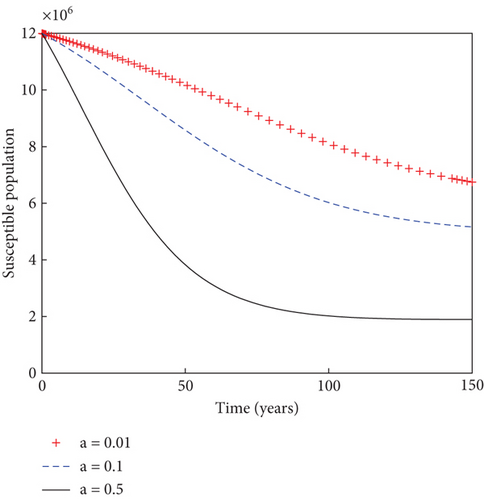
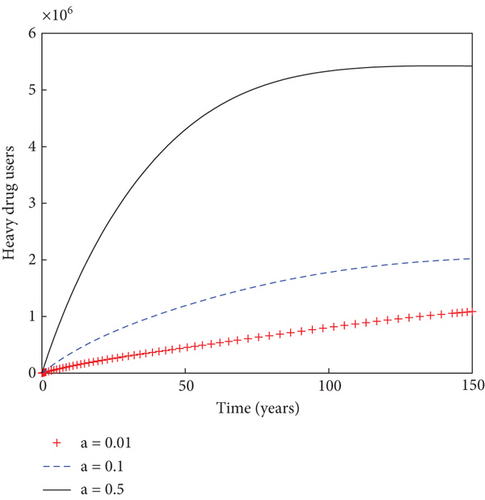
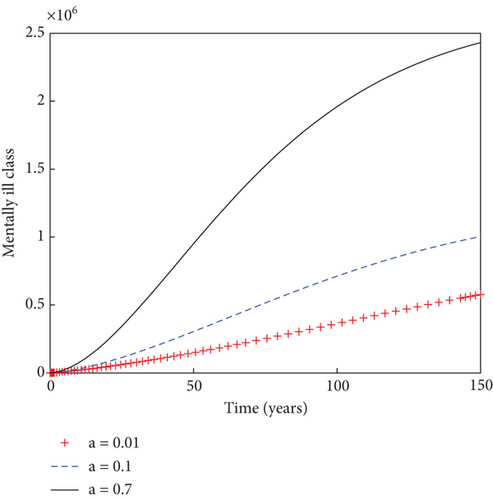
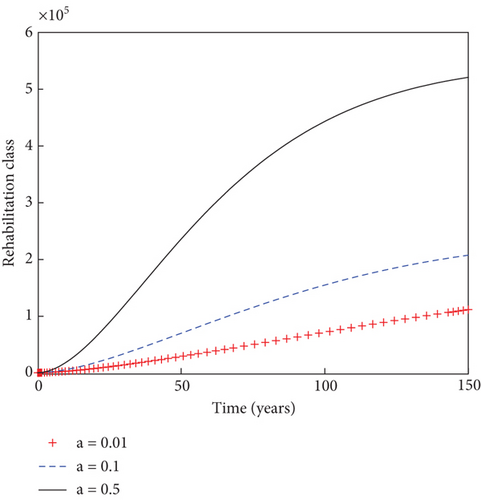
In Figure 7, it can be seen that increase in the reactivation rate of substance abuse influence, denoted by βr, from 1% to 90% slightly increases the populations of light and heavy drug users, as well as mentally ill population. This in turn decreases the sizes of individuals under rehabilitation. As the rate of rehabilitating heavy drug users increases from 1% to 50% in Figure 8, the populations of light drug users, heavy drug users, and mentally ill individuals decrease in sizes, while there is an increase in the number of individuals under rehabilitation. This result underscores the importance of rehabilitation in the fight against the negative influence of psychoactive substance abuse in the population.
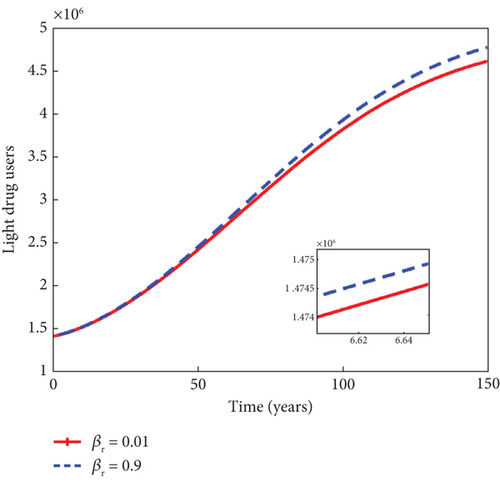
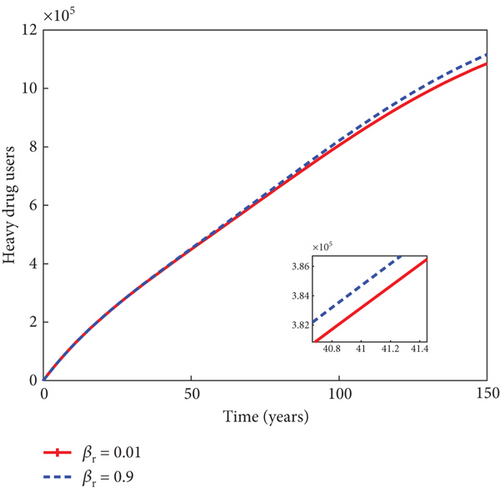
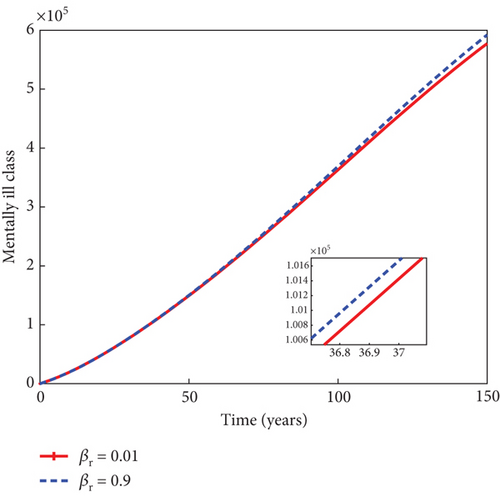
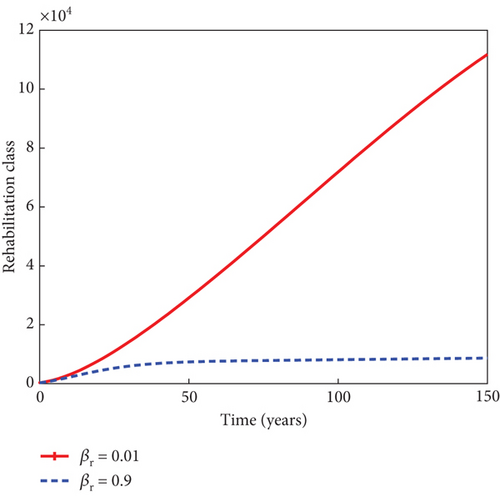
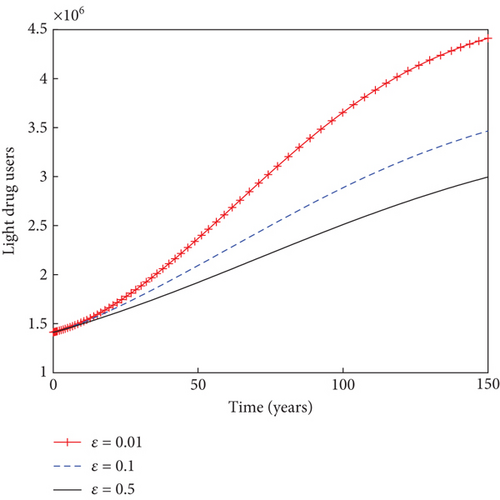
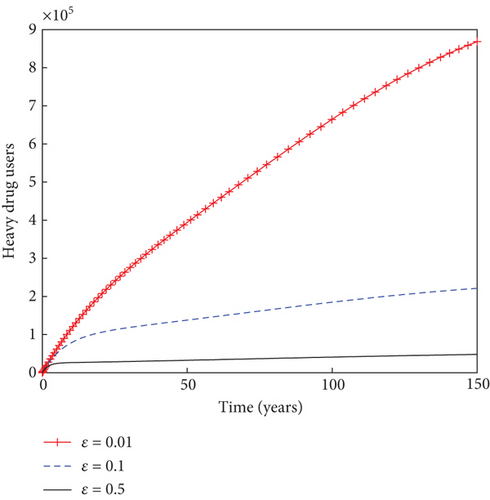
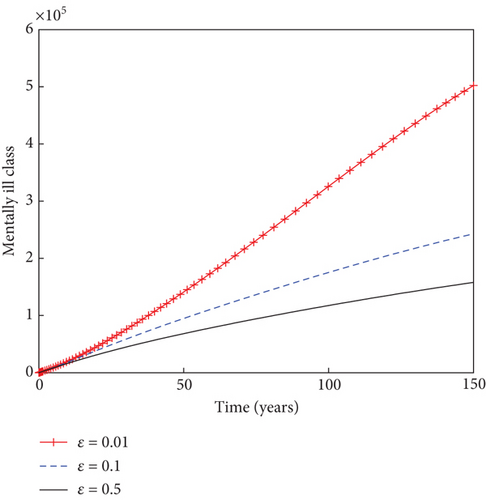
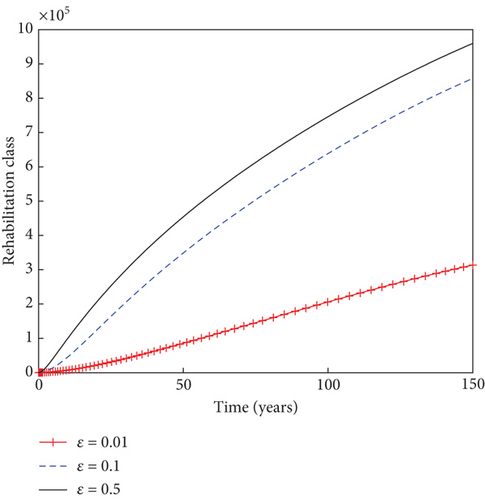
5. Conclusion
- i.
The model has substance abuse–free and substance abuse–present steady state solutions that coexist at the effective reproduction number less than unity, thereby making the control of drug abuse problem difficult.
- ii.
The coexistence of the aforesaid two steady states is caused by the unhindered influx of immigrants who are heavy drug users in the population.
- iii.
In the absence of immigrant heavy drug users, when the effective reproduction number is below one, the model is shown to have a globally asymptotically stable substance abuse–free steady state.
- iv.
A globally asymptotically stable substance abuse–present equilibrium point exists when the effective reproduction number is greater than unity.
- v.
The increased presence of prudent fraction of the recruitment of human population reduces the sizes of light drug users, heavy drug users, and substance abuse–induced mental cases in the community.
- vi.
The model’s most sensitive parameter with respect to the effective reproduction number is the influence rate of the substance abuse from both light and heavy drug users.
Overall, this study contributes to our understanding of the population dynamics of substance abuse in the presence of immigrant drug abusers and prudent individuals. Building on the aforementioned findings, future studies might investigate, via optimal control modelling approach, the optimum interventions for hampering the influence of drug users on the susceptible population and for checking the immigration of drug users with a view to further nipping the problem of drug abuse in the bud.
Conflicts of Interest
The authors declare no conflicts of interest.
Author Contributions
S.O. conceptualized the problem; S.O., J.A.A., and S.F.A. did the formal analysis; J.A.A. and S.F.A. wrote the original draft; F.M.C., R.C.O., R.S.L., and K.O.O. investigated and validated results. All authors reviewed and edited the manuscript.
Funding
This research received no external funding.
Open Research
Data Availability Statement
The data that support the findings of this study are available within the article, as obtained from Neuro-Psychiatric Hospital, Yaba, Lagos, Nigeria.



